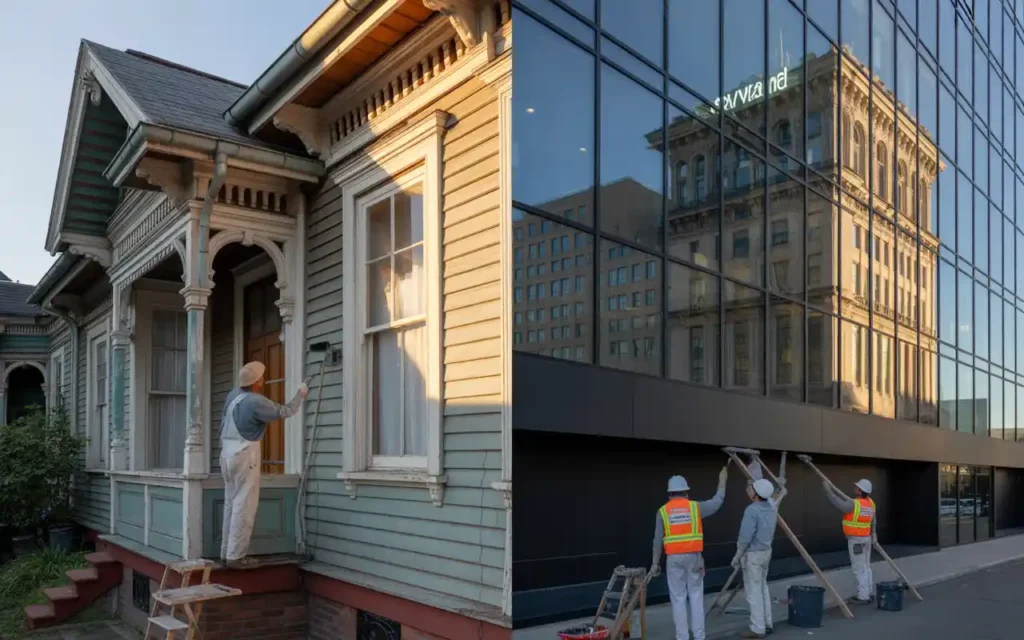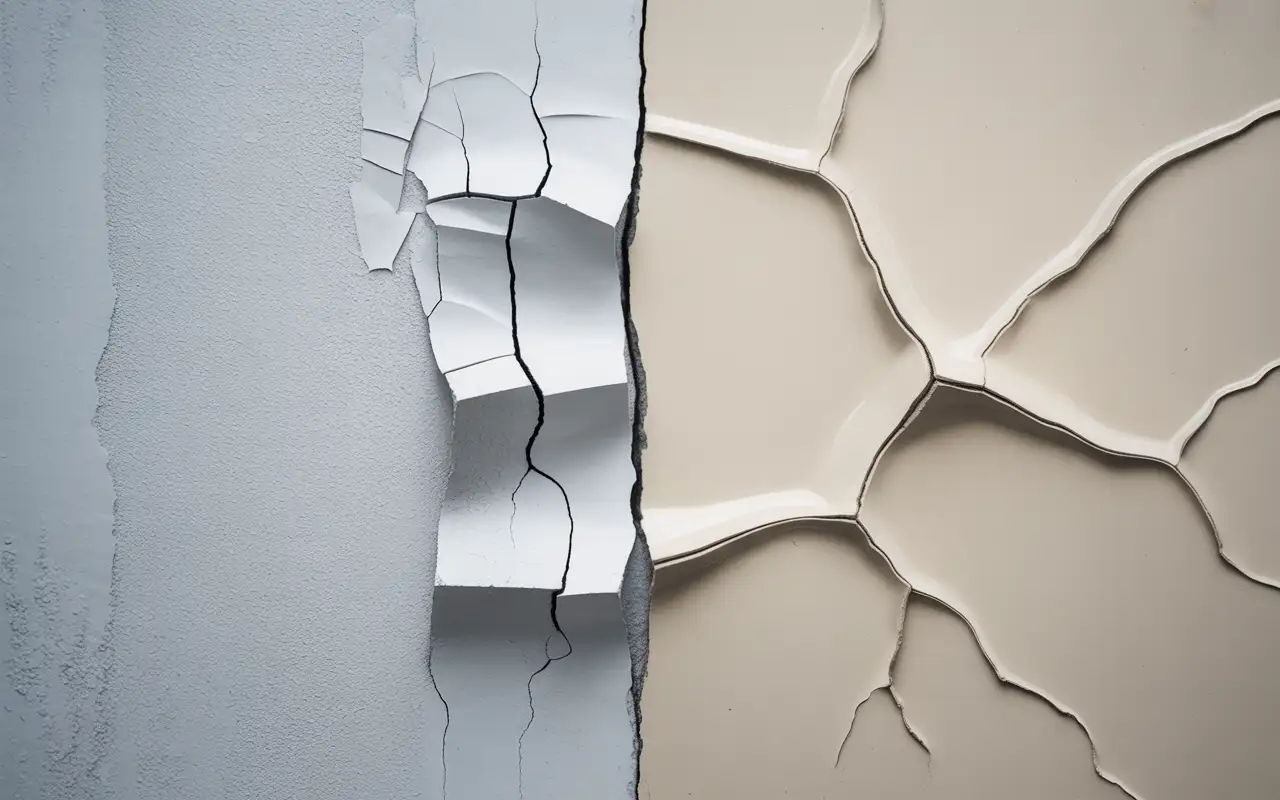Many people think painting is the same whether it’s a home or a business. They believe a wall is just a wall. Unfortunately, that is far from being the case as Residential and Commercial painting require different skillsets, tools, and approaches for success.
The differences go beyond just the size of the building. From the equipment used to the type of paint applied, each service has unique requirements. Understanding these differences helps you hire the right painting contractors for your project.
Table of Contents
ToggleResidential vs. Commercial Painting
Residential painters focus on homes and living spaces. They paint houses, townhouses, and condos. These projects are smaller and take less time. A typical home job needs two or three painters and basic equipment like brushes, rollers, and drop cloths.
Commercial painters specialise in larger buildings such as office spaces, retail stores, hospitals and schools. Such projects often require larger teams with heavier equipment to complete. Work can sometimes occur at night or over weekends to minimise business operations interruption.
The work environment differs significantly between the two. Residential projects involve working closely with homeowners. Commercial jobs require coordination with business owners, managers, and sometimes other contractors on-site.
The Main Distinctions between Commercial and Residential Painting

1. Size and Scope of the Project
The most obvious difference is project size. Residential projects cover a few rooms or maybe a whole house. Even large homes are small compared to commercial buildings. A single commercial building can have the square footage of ten homes or more.
Commercial painting projects include shopping malls, airports, manufacturing facilities, and apartment complexes. These spaces need more painters, more paint, and more time. A residential project might take a few days. A commercial job can take weeks or even months.
2. Materials and Equipment
Residential painters use tools you might find at a hardware store. They work with paintbrushes, rollers, painting trays, step ladders, and cleaning materials. The equipment is simple but effective for home jobs.
Commercial painters need industrial-grade equipment. They use pressure washers, sandblasters, paint sprayers, scaffolding, and aerial lifts. This equipment costs thousands of dollars and requires special training. They also work with specialty coatings, epoxy systems, and high-durability paints that aren’t used in homes.
The surfaces are different too. Residential painters deal with drywall, wood, and stucco. Commercial painters must know how to paint concrete, metal, marble, reinforced plastic, and other industrial materials. Each surface needs a different approach and different products.
3. Types of Paint and Finishes
Home painting uses standard paint types. Most residential paint is latex-based or water-based. These paints are easy to clean up and safe for indoor use. Oil-based paints are sometimes used for trim and cabinets.
Paint sheens matter in homes. Homeowners choose from flat, eggshell, matte, satin, semi-gloss, and gloss finishes. Flat paint hides wall imperfections. Glossy paint is easier to clean and works well in kitchens and bathrooms.
Commercial spaces need tougher paint. Business buildings use industrial-grade coatings designed to last longer and resist damage. High-traffic areas need paint that can handle constant use. Some commercial spaces require special fire-resistant or antimicrobial coatings that meet safety codes.
4. Number of Workers
Team size depends on the job. A typical residential project needs two or three painters. They can finish most homes in a few days without issues.
Commercial painting companies employ larger crews. A big project might need ten or more painters working at once. Multiple teams work different shifts to meet tight deadlines. This coordination takes careful planning and strong management.
5. Services Provided
Residential painters offer services that homeowners need. These services include interior and exterior painting, cabinet painting, deck staining, fence painting, wallpaper removal, drywall repair, and garage painting. Some also do light construction work or popcorn ceiling removal.
Commercial services include specialized work. The services include brick waterproofing, concrete ceiling repair, line striping for parking lots, masonry coating, roof coatings, metal door painting, joint expansion sealing, and waterproof coatings. Many commercial painters also offer sandblasting, metalizing, and epoxy floor coatings.
6. Scheduling and Timeline
Residential projects happen during normal business hours. Painters work Monday through Friday, usually eight hours a day. Homeowners can stay during the work or leave for the day. The schedule is flexible and based on what works for the family.
Commercial work follows a different schedule. Businesses stay open while painting happens. This means painters work around customers and employees. Many commercial jobs happen at night, on weekends, or during holidays. The goal is to avoid business disruptions and lost revenue.
Meeting deadlines is critical for commercial work. Every day of delay costs money. Contractors must manage their time carefully and adjust when problems arise.
7. Project Management and Planning
Commercial jobs need detailed planning. Project managers coordinate multiple teams, order materials weeks ahead, and track progress daily. They work with building managers, safety inspectors, and other contractors. One mistake can delay the whole project and cost thousands of dollars.
Residential projects are simpler to manage. The focus is on homeowner satisfaction and quality work. Changes are easier to make. If a homeowner wants a different color halfway through, the painter can adapt without major issues.
8. Experience and Expertise
Residential painters excel at customer service. They help homeowners pick colors that match their furniture and style. They protect floors and furniture with care. They know how to work in occupied homes without causing too much disruption.
These painters understand interior painting and exterior painting for homes. They work with vinyl siding, fiber-cement siding, wood, and stucco. They know which products work best for each surface type.
Commercial painters need different skills. Safety training is required because they work at heights and in hazardous conditions. They must follow OSHA regulations and local building codes. Their knowledge covers many surface types and specialty coatings that most homeowners never see.
9. Safety and Risk Management
Safety is important for all painting jobs. But commercial work has higher risks. Painters work on tall buildings using scaffolding and aerial lifts. One mistake can cause serious injury or death. Commercial painters wear safety harnesses, hard hats, and other protective gear.
These projects also carry business risks. Delays cost money. Poor quality affects a company’s brand image. Commercial painters carry higher insurance coverage to protect against accidents and property damage.
Residential work is safer overall. Painters work closer to the ground. The environment is more controlled. Still, professional painters take precautions to protect themselves and your property.
10. Cost and Budget Considerations
Commercial projects cost more because they’re larger and more complex. The paint alone can cost tens of thousands of dollars. Equipment rental, labor, and specialty materials add up quickly. Businesses budget for these costs as part of their maintenance plans.
Residential paint costs less but quality matters. Good paint provides better coverage and lasts longer. Cheap paint needs more coats and fades faster. Professional painters help homeowners find the right balance between cost and quality.
Commercial jobs often include maintenance contracts. Businesses pay for regular touch-ups and inspections. This prevents small problems from becoming big expenses.
11. Permits and Regulations
Commercial painting often requires permits. Building codes dictate what types of paint can be used in certain spaces. Fire codes require specific coatings in hallways and exits. Environmental regulations limit VOC levels in paints.
Residential projects rarely need permits unless you’re changing exterior colors in a historic district. The regulations are less strict. Still, good painters use low-VOC paints that are safer for families.
Can One Contractor Handle Both?
Some painting contractors specialize in one type. Others offer both residential and commercial painting services. The skills overlap but the scale differs greatly.
A contractor who does both needs diverse equipment and trained staff. They must understand home design and business needs. Not every painting company can manage this range effectively.
When choosing a contractor, ask about their experience with your specific project type. A company great at residential work might struggle with commercial complexity. A commercial specialist might not give your home the personal attention you want.
The SD Custom Painting Can Handle Both Types of Painting
SD Custom Painting has experience with both residential projects and commercial spaces. Our team knows the unique challenges each type of painting presents. We use the right tools and techniques for every job.
For homes, we offer interior painting services in San Diego that transform your living spaces. Our exterior painting services protect your home from weather damage while improving curb appeal. We also specialize in cabinet painting that updates your kitchen without the cost of replacement.
Our commercial clients trust us with their business image. We work around your schedule to minimize disruptions. Our painters follow all safety protocols and building codes. We handle everything from small retail shops to large office complexes.
Whether you need a single room painted or an entire building renovated, we provide quality work and clear communication. Our team respects your property and your time. We finish projects on schedule and within budget.
FAQs
What’s the main difference between residential and commercial painting?
The main difference is scale and complexity. Commercial jobs are larger, need more workers, and use industrial equipment. Residential jobs are smaller, more personal, and use standard painting tools.
Can residential painters do commercial work?
Not always. Commercial work requires special equipment, safety training, and experience with industrial materials. A residential painter might not have these qualifications.
Why does commercial painting cost more?
Commercial projects use more paint, need bigger crews, and require specialty equipment. The regulations are stricter and the stakes are higher. All these factors increase costs.
How long does each type of project take?
A residential project takes a few days to a week. Commercial projects can take weeks or months depending on the building size and scope of work.
Do I need permits for painting my home?
Usually not, unless you’re in a historic district or changing colors in a regulated area. Commercial projects often need permits and inspections.
What type of paint lasts longer?
Commercial-grade paint typically lasts longer because it’s made for high-traffic areas and harsh conditions. For homes, quality latex or acrylic paint provides good durability at a lower cost.
Should I hire a company that does both types?
It depends on their experience level. A company skilled in both can handle any project. But make sure they have specific experience with your project type.
Is commercial painting more dangerous?
Yes, commercial work involves more safety risks. Painters work at heights, use heavy equipment, and deal with hazardous materials. This requires special training and safety gear.





